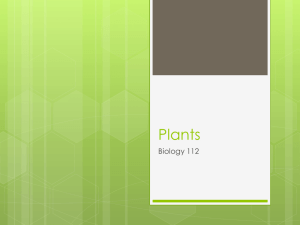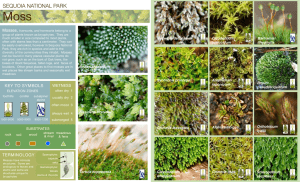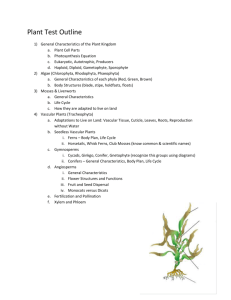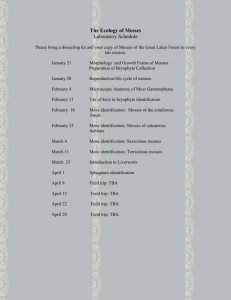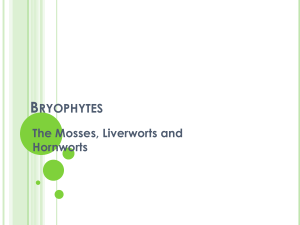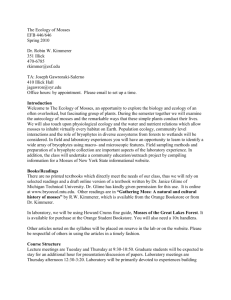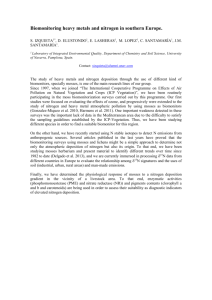Heavy metal accumulation by Mosses as affected by roadside pollutants
advertisement
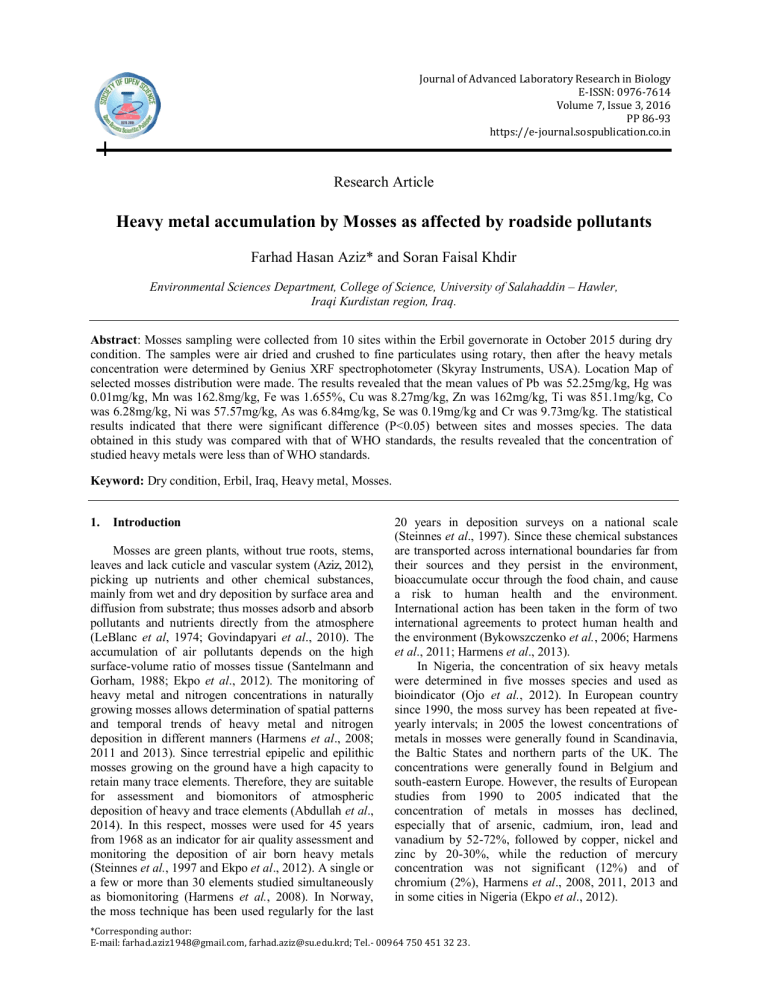
Journal of Advanced Laboratory Research in Biology E-ISSN: 0976-7614 Volume 7, Issue 3, 2016 PP 86-93 https://e-journal.sospublication.co.in Research Article Heavy metal accumulation by Mosses as affected by roadside pollutants Farhad Hasan Aziz* and Soran Faisal Khdir Environmental Sciences Department, College of Science, University of Salahaddin – Hawler, Iraqi Kurdistan region, Iraq. Abstract: Mosses sampling were collected from 10 sites within the Erbil governorate in October 2015 during dry condition. The samples were air dried and crushed to fine particulates using rotary, then after the heavy metals concentration were determined by Genius XRF spectrophotometer (Skyray Instruments, USA). Location Map of selected mosses distribution were made. The results revealed that the mean values of Pb was 52.25mg/kg, Hg was 0.01mg/kg, Mn was 162.8mg/kg, Fe was 1.655%, Cu was 8.27mg/kg, Zn was 162mg/kg, Ti was 851.1mg/kg, Co was 6.28mg/kg, Ni was 57.57mg/kg, As was 6.84mg/kg, Se was 0.19mg/kg and Cr was 9.73mg/kg. The statistical results indicated that there were significant difference (P<0.05) between sites and mosses species. The data obtained in this study was compared with that of WHO standards, the results revealed that the concentration of studied heavy metals were less than of WHO standards. Keyword: Dry condition, Erbil, Iraq, Heavy metal, Mosses. 1. Introduction Mosses are green plants, without true roots, stems, leaves and lack cuticle and vascular system (Aziz, 2012), picking up nutrients and other chemical substances, mainly from wet and dry deposition by surface area and diffusion from substrate; thus mosses adsorb and absorb pollutants and nutrients directly from the atmosphere (LeBlanc et al, 1974; Govindapyari et al., 2010). The accumulation of air pollutants depends on the high surface-volume ratio of mosses tissue (Santelmann and Gorham, 1988; Ekpo et al., 2012). The monitoring of heavy metal and nitrogen concentrations in naturally growing mosses allows determination of spatial patterns and temporal trends of heavy metal and nitrogen deposition in different manners (Harmens et al., 2008; 2011 and 2013). Since terrestrial epipelic and epilithic mosses growing on the ground have a high capacity to retain many trace elements. Therefore, they are suitable for assessment and biomonitors of atmospheric deposition of heavy and trace elements (Abdullah et al., 2014). In this respect, mosses were used for 45 years from 1968 as an indicator for air quality assessment and monitoring the deposition of air born heavy metals (Steinnes et al., 1997 and Ekpo et al., 2012). A single or a few or more than 30 elements studied simultaneously as biomonitoring (Harmens et al., 2008). In Norway, the moss technique has been used regularly for the last 20 years in deposition surveys on a national scale (Steinnes et al., 1997). Since these chemical substances are transported across international boundaries far from their sources and they persist in the environment, bioaccumulate occur through the food chain, and cause a risk to human health and the environment. International action has been taken in the form of two international agreements to protect human health and the environment (Bykowszczenko et al., 2006; Harmens et al., 2011; Harmens et al., 2013). In Nigeria, the concentration of six heavy metals were determined in five mosses species and used as bioindicator (Ojo et al., 2012). In European country since 1990, the moss survey has been repeated at fiveyearly intervals; in 2005 the lowest concentrations of metals in mosses were generally found in Scandinavia, the Baltic States and northern parts of the UK. The concentrations were generally found in Belgium and south-eastern Europe. However, the results of European studies from 1990 to 2005 indicated that the concentration of metals in mosses has declined, especially that of arsenic, cadmium, iron, lead and vanadium by 52-72%, followed by copper, nickel and zinc by 20-30%, while the reduction of mercury concentration was not significant (12%) and of chromium (2%), Harmens et al., 2008, 2011, 2013 and in some cities in Nigeria (Ekpo et al., 2012). *Corresponding author: E-mail: farhad.aziz1948@gmail.com, farhad.aziz@su.edu.krd; Tel.- 00964 750 451 32 23. Affect on Mosses by roadside pollutants Since there are no studies using mosses in this field of science in Iraq and Kurdistan region. The aim of this study is to estimate environmental air pollution caused by heavy metal deposition on the main road in Erbil Governorate. 2. Materials and Methods 2.1 Site description Erbil is the capital of Iraqi Kurdistan region. It’s located in the north part of Iraq; Erbil borders of Turkey to the north and Iran to the east. Geographically Erbil is elevated by about 411m above sea level. Erbil Governorate covers an area of 164840 km2 in the north of Iraq (Fig. 1). Erbil Governorate longitude is 42˚ 15’E to 46˚ 30’E and latitude is 34˚ 25’N to 37˚ 50’N. In order to conduct the present study, 10 locations were selected from the north of Erbil governorate and inside Erbil city as described in (Table 1). The studied locations were covered the major area as possible based on the traffic activity as most of them located on the main roads of Erbil city and Hamilton main road toward Soran district. The area of this study located between 36˚ 19' 5177N, 44˚ 009414E and 36˚ 37.562N, 43˚ 34.422E (Hama et al., 2014). 2.2 Geology, soil, and climate Geologically, Erbil situated within recent sediment which belongs to Paleocene age that represents old river Aziz and Khdir sedimentation, which came from Bakhtiari formation (WFP, 2002). The stone of these sediments differs and compose of lenticels and stereographs with stone, sand, silt and alluvial, the thicknesses of the sediments vary largely within Erbil governorate (Muhammad, 2003). The soil of Kurdistan Region of Iraq is calcareous because it is originated from limestone and dolomite of different formation mostly. Erbil soil is brown which occurs under the effect of climatic conditions. The soil has a brown surface layer of about 25-30cm depth gradient into a brownish-gray to whitish horizon of lime accumulation (Buringh, 1960; Brady, 1974). Soil formation of Erbil province ranges from mountainous to foothill soil; mountainous soil formation exists in high folded zone and characterized by dark brown to black color on the upper surface, while it's pink and yellowish color in subsurface and consists of lime and about 4-8% organic matter (Guest, 1966). In foothills, the soils are sandy with clay and suitable for agriculture, in the undulating terrain the soil is generally gravelly, sandy and clay or loam of grayish color and no gravels. Generally, the topsoil is calcareous and may contain 12% of organic matter in foothills the soil are sandy with clay and suitable for agriculture, while in the undulating terrain the soil is generally gravelly, sandy with clay and of a brownish color. In the plain, the soils are deep and consist of silty and sandy clay or loam of grayish color, and no gravels (Buringh, 1960). Fig. 1a. Map of Iraq, Kurdistan; Fig. (1b). Map of studied area shows the sampling location. J. Adv. Lab. Res. Biol. 87 Affect on Mosses by roadside pollutants Aziz and Khdir Table 1. Description of the studied location. # Name of location 1 Center of Erbil, Aras strees 2 College of Science 3 College of Science 4 Gali Ali Beg beside waterfall 5 6 7 8 Latitude / longitude 36˚ 195177N/ 44˚ 009414E 36˚ 152526N/ 44˚ 019854E 36˚ 152833N/ 44˚ 021064E 36˚ 631183N/ 44˚ 445962E Gali Ali beg main 36˚ 627812N/ road to Soran district 44˚ 452166E Bekhal-Rawanduz, 36˚ 36.143N/ Malla nabi well 044˚ 30.013E Bekhal-Rawanduz, 36˚ 36.143N/ near Malla nabi well 044˚ 30.15.85E Bekhal-Rawanduz, 36˚ 36.12.53N/ near Malla nabi well 044˚ 30.14.42E 9 Jondian 36˚ 37.562N/ 044˚ 34.422E 10 Gulan Street, Erbil City 36˚ 219213N/ 44˚ 024302E Description It is located inside Erbil city beside Aras street which is the road between Tairawa and Ibn-Al Mstawfi quarter. Hundreds of vehicles per day are passing. It is located opposite of cafeteria of College, has very low traffic activity. This is located beside Hall of Environment in College of Science, has very low traffic. 70 Kilometers away from Erbil city, near Gali Ali Beg road. Its main road between Erbil and Soran district, with high traffic load; thousands of vehicles are passed by this area on daily basis; hot and dry in summer, moist, cloudy, rainy in winter up to 1000mm/year. Several Kilometers away from Erbil city and few Kilometers far from Gali Ali Beg waterfall. Its main road between Erbil and Soran district, it is a high traffic road; Hundreds of vehicles are passed by this area on daily basis; hot and dry condition in summer, moist, cloudy, rainy in winter up to 1000mm/year. A few Kilometers away from Rawanduz; characterized by hot and dry condition in summer, moist, cloudy, and rainy in winter. A few Kilometers away from Rawanduz characterized by hot and dry in summer, moist, cloudy, and rainy in winter. A few Kilometers away from Rawanduz, characterized by hot, dry in summer and moist, cloudy, rainy in winter. A few Kilometers away from Soran district, this is the main road to Haji Omran the border point between Iraq and Iran. It is a high traffic road; Hundreds of vehicles are passed by this area on daily. It has the same climate. It is a high traffic road; hundreds of vehicles are passed by this area on daily basis. Funaria Hygrometrica Hedw. Tortula ruralis Hedw. Grimmia pulvinata Hedw. Cirriphyllum piliferum Hedw. (a) Brachythecium rivulare Hedw. (b) Brachythecium rivulare Hedw. Plate 1. The indicator mosses species used in this study. J. Adv. Lab. Res. Biol. 88 Affect on Mosses by roadside pollutants Aziz and Khdir The climate of Erbil area is most closely approaches the Iran-Turanian type, and it’s similar to that of the other parts of Kurdistan region and the other northern parts of Iraq, which is semi-arid and characterized by hot dry summer and moderately rainy cold winter. The higher altitude parts of the area have colder winters and receive more precipitation than the area of lower elevations (WFP, 2002). Usually, precipitation occurs during the months from September until April, rainfall, and humidity play a great role on the climate, all together with temperature. The climate is characterized by the assurance of four seasons, cold winter and mild growth periods of spring, hot dry summer and autumn pointed out that period from June to the end of January is rainless, whereas the wettest months are between March and April (Hama et al., 2014). 3. Mosses In this study, the used mosses plants were represented in the Table below. Sites 1 2 3 4 5 6 7 8 9 10 Identified Sample Funaria Hygrometrica Hedw. Funaria Hygrometrica Hedw. Funaria Hygrometrica Hedw. Tortula ruralis (Hedw.) G. Gaertn., B. Mey. and Scherb. Brachythecium rivulare Hedw. Grimmia Pulvinata Hedw. Tortula ruralis (Hedw.) G. Gaertn., B. Mey. and Scherb. Cirriphyllum piliferum Hedw. Funaria Hygrometrica Hedw. Tortula ruralis (Hedw.) G. Gaertn., B. Mey. and Scherb. 3.1 Analyze of plant materials All plant and soil samples were air dried first for 10 days at room temperature. In order to obtain concentrations on a dry matter basis, the samples were further dried in the dryer for 24 h at 50°C, then samples were segregated, cleaned and powdered. The dried plant material was ground in a laboratory mill into fine powder (average particle diameter 100µm). To avoid contamination, the mill was thoroughly cleaned and dried after each grinding. The powdered dried of plant tissues (leaves) were analysed by XRF spectrophotometer or Genius XRF, Skyray Instrument Inc (Steinnes, 1980; Røyset et al., 1995; Ene et al., 2010). The data was statistically analyzed using analysis variance (2 way ANOVA) and when the result where significant was applied L.S.D. The L.S.D value as mentioned by Abdulla et al., (2014) was calculated by: L.S.D = . . 4. or/and L.S.D = Results 4.1 Temperature During of the studied period, the highest temperature value (37.05˚C) was recorded at Makhmour location during July 2015 while lowest temperature value (6.2˚C) was recorded at Choman district during the month of March 2015 (Table 3). Table 3. Monthly mean air temperature (˚C) values for the of study location within Erbil governorate during wet condition Mar, Apr and May and dry condition Jul, Aug and Sept 2015. Months Location Erbil center Choman district Soran district Rawanduz district Harir district Shaqlawa district Salahaddin sub-district Makhmour district Mean Wet condition Dry condition Mar. Apr. May Jul. Aug. Sep. 10.21 15.7 20.11 36.2 35.0 27.8 6.2 14.6 20.8 31 28 25.9 7.4 17.4 22.7 31.3 31.1 27.4 9.6 16 22 30.3 31.1 27 6.5 16.3 24.5 31.2 33.8 29.9 6.5 15.7 19.6 28.1 28 23.3 11.2 21.95 27.1 35.9 35.15 30.8 12.3 25.05 28.3 37.05 36.7 32 8.73 17.83 23.13 32.63 32.35 28.01 Source: Meteorological Center of Erbil, LSD (P<0.01) = 7.44 4.2 Humidity The relative humidity of studied location during the studied period was presented in Table 4. Results revealed that during wet condition the humidity percentage was more than during dry condition, in wet condition it was ranged from 30-74.2, while during dry condition ranged from 18.5-55.6 Table 4. Monthly relative humidity (%) and rainfall value of the locations within Erbil Governorate during wet condition March, April, May and dry condition July, August and, September 2015. Months Area Choman district Soran district Rawanduz district Harir district Shaqlawa district Salahaddin sub district Makhmour district Mean Humidity % Mar 74.2 71.7 73.1 61.1 64.7 62 53 65.7 Wet Apr 64.8 64.4 66.2 53 54 50 40 56.1 May 59.6 62 63 32.5 43.5 42 30 47.5 Jul 53.3 52.2 53 19 21 22 25 35.1 Dry Aug 31.7 53.3 52 18.9 18.9 29 25 32.7 Sep 51.3 55.6 51.3 18.5 18.5 29 28 36.0 Mar 126.4 108.3 123 165 167 72.1 26.5 112.6 Rainfall (mm/years) wet Dry Apr May Jul Aug 52.6 17.3 0 0 51.2 17.1 0 0 52.3 17.7 0 0 32.3 6.7 0 0 34.5 12 0 0 14.5 26.8 T.R 0 8 3.3 0 0 35.1 14.4 0 0 Sep 0 0 0 0 0 0.2 T.R 0.03 Source: Meteorological Center of Erbil, LSD of humidity (P<0.01) = 31.2, LSD of rainfall (P<0.01) = 47.79 J. Adv. Lab. Res. Biol. 89 Affect on Mosses by roadside pollutants Aziz and Khdir -1 Table 5. The mean concentration (mg/kg ) of heavy metal in mosses in the studied samples in dry condition. Sites Pb Hg Mn Fe% 1 100 0.0 213 2.25 2 58 0.0 220 2.24 3 93 0.0 290 2.64 4 35 0.0 100 1 5 29 0.0 63 0.66 6 46 0.0 202 2.18 7 44 0.0 151 1.55 8 33 0.0 56 0.71 9 41.5 0.1 116 0.96 10 43 0.0 217 2.36 Total 522.5 0.1 1628 16.55 mean 52.25 0.001 162.8 1.655 S.D 24.69 0.031 77.52 0.76 * Over range of the instrument reading, - Not detected. Cu 300 69 114 25 26 25 26 40 32 25.7 682.7 68.27 86.30 Zn Ti * 1560 659 1954 * * 140 403 389 380 100 1209 82 685 59 471 113 369 78 1480 1620 8511 162 851.1 212.53 611.27 Co 7.9 7.7 10 4.5 3.3 7.9 5.8 3.4 4.2 8.1 62.8 6.28 2.34 Ni 51 59 82 125 22.7 49 45 44 30 68 575.7 57.57 29.22 As 16 12 6.8 3.1 4.1 7 5.6 2.8 4 7 68.4 6.84 4.18 Se 0.2 0.2 0.1 0.1 0.4 0.3 0.1 0.1 0.1 0.3 1.9 0.19 0.11 Cr 40 32 6.6 18.7 97.3 9.73 14.72 -1 Table 6. The mean Concentration (mg/ kg ) of heavy metals of two moss species samples in dry condition collected in October at study sites. Mosses spp. Funaria Heavy Metal Sites 1 2 3 9 4 Pb 100 58 93 41.5 35 Hg 0 0 0 0.1 0 Mn 213 220 290 116 100 Fe (%) 2.5 2.24 2.64 0.96 1 Cu 300 69 114 32 25 Zn * 659 * 113 140 Ti 1560 1954 * 369 403 Co 7.9 7.7 10 4.2 4.5 Ni 51 59 82 30 125 As 16 12 6.8 4 3.1 Se 0.2 0.2 0.1 0.1 0.1 Cr 40 0 32 0 6.6 * Over range of the instrument reading; - Not detected. 4.3 Heavy metals in mosses Heavy metal concentration in studied mosses plants and location represented in Tables 5 and 6. The results were as follows: Pb: The highest concentration was 100mg/kg-1 recorded in Funaria at Aras Street at Erbil center location, while the minimum concentration was 35mg/kg-1 recorded in Tortula at Gali Ali Bag road, with the mean value of 59.21. Hg: The highest concentration was 0.1mg/kg-1 recorded in Funaria at Jondian, Soran district location, while the minimum concentration was 0.0mg/kg-1 recorded in all location except Jondian location, the mean value was 0.014. Mn: The highest concentration was 290mg/kg-1 recorded in Funaria at College of Science, Erbil city, while the minimum concentration was 100 mg/kg-1 recorded in Tortula under Gali Ali Beg waterfall, the mean value was 186.71. Fe (%): The highest concentration was 2.64% recorded in Funaria at College of Science, while the minimum concentration was 0.96% recorded in Funaria at J. Adv. Lab. Res. Biol. Tortula Sites 7 44 0 151 1.55 26 82 685 5.8 45 5.6 0.1 0 10 43 0 217 2.36 25.7 78 1480 8.1 68 7 0.3 18.7 Total Mean S.D LSD 414.5 0.1 1307 13.25 591.7 1072 6451 48.2 460 54.5 1.1 97.3 59.21 26.46 14.14 0.014 0.03 0.020 186.71 67.30 35.97 1.89 0.71 0.38 84.52 100.60 53.77 153.14 249.81 133.52 921.57 674.39 360.47 6.88 2.11 1.132 65.71 30.96 16.54 7.78 4.61 2.46 0.15 0.07 0.042 13.9 16.65 8.90 Jondian, Soran district location, the mean value was 1.89. Cu: The highest concentration was 300mg/kg-1 recorded in Funaria at Aras Street at Center of Erbil, while the minimum concentration was 25mg/kg-1 recorded in Tortula under Gali Ali Beg waterfall, the mean value was 84.52. Zn: The highest concentration was over range recorded in Funaria at Aras Street and at College of Science, while the minimum concentration was 78mg/kg-1 recorded in Tortula at Gulan Street-Erbil City, the mean value was 153.14. Ti: The highest concentration was over range recorded in Funaria at College of Science, while the minimum concentration was 369mg/kg-1 recorded in Funaria at Jondian, Soran district location, the mean value was 921.57. Co: The highest concentration was 10mg/kg-1 recorded in Funaria at College of Science, while the minimum concentration was 4.2mg/kg-1 recorded in Funaria at Jondian, Soran district location, the mean value was 6.88. 90 Affect on Mosses by roadside pollutants Ni: The highest concentration was 125mg/kg-1 recorded in Tortula under Gali Ali Beg waterfall, while the minimum concentration was 30mg/kg-1 recorded in Funaria at Jondian, Soran district location, the mean value was 65.71. As: The highest concentration was 16mg/kg-1 recorded in Funaria at Aras Street at Erbil city location, while the minimum concentration was 3.1mg/kg recorded in Tortula under Gali Ali Beg waterfall, the mean value was 7.78. Se: The highest concentration was 0.3mg/kg-1 recorded in Tortula at Gulan Street-Erbil City, while the minimum concentration was 0.1mg/ kg-1 recorded in Funaria at College of Science, Jondian-Soran district location and in Tortula under Gali Ali Beg waterfall and near Malla Nabi Water well Bekhal-Rawanduz road, the mean value was 0.15. Aziz and Khdir Cr: The highest concentration was 40mg/kg-1 recorded in Funaria at Aras Street at Erbil city, while the minimum concentration was 6.6mg/kg-1 recorded in Tortula under Gali Ali Beg waterfall, the mean value was 13.9. 4.4 Heavy Metals in Soil The concentration of heavy metal, in the soil of some location was shown in (Table 7). The result reviewed that in Erbil city center and the main road, was as follows for Pb ranged from 0.12 to 0.91, Cd from 0.80 to 3.02, for Cr from 77.19 to 195.85, for Cu from 18.01 to 33.18, for Zn from 126.60 to 156.16 and for Mn 299.44 to 586.04 (ppm). The similar results was obtained by (Kaminski and Landsberger, 2000; Ojo et al., 2012 and Qadir, 2011) who studied the heavy metal concentration in lichens within Erbil governorate. No relationship found between heavy metal concentration in mosses and soil of some sites; this is similar to the result of (Abdullah et al., 2014). Table 7. Heavy metal concentration (ppm) in mosses and in the soil of some main road of mosses sampling within Erbil city. Main Road Erbil Rawanduz Gali Ali Beg Shaqlawa Pb 0.71 0.12 0.15 0.91 Cd 3.02 1.01 0.9 0.8 Cr 166.19 195.85 146.94 77.19 Cu 35.18 22.82 34.86 18.01 Fe 1345.11 15013.04 1648.32 1023.76 Zn 245.78 144.77 156.16 426.6 Mn 328.74 412.88 586.04 299.44 *In natural subsoil Pb = 0.05-5.0 ppm; *In shoot of herbaceous roadside plants = 12.0-35.0 ppm; *In roadside tree plant 0.0, 5.0 – 23.25 ppm. Heavy Metal 5. Discussion As in the present study of which more attention paid to Funaria Hygrometrica, Tortula ruralis, Brachythecium rivulare, Cirriphyllum piliferum, Grimmia Pulvinata, investigations carried out in Poland concerned with the Hypnum cupressiforme var. filiforme and Orthodicranum montanum mosses, they were useful as good bioindicators for environmental pollution by heavy metals. These taxons were chosen because of their abundance on the examined area as well in the industrial zone and in the clean or not polluted area. In the majority of samples, low contents of molybdenum and high contents of zinc were found. In the area of the steel factory near the main road from Erbil to Gwer sub-district. Other workers stated that the influence of industrial and communication factors play a great role in higher contents of metals such as Cd, Zn, Mo, Ni and Pb in samples of mosses (LeBlanc & Rao, 1974; Baranowska and Srogi, 2000). Concerning polluted and unpolluted area along the main road and Erbil center the results agree with that of Baranowska and Srogi, (2000). They found that the mean heavy metal concentrations in mosses collected in 1995 across Poland were: Zn – 43.0μg/g d.m., Fe – J. Adv. Lab. Res. Biol. Total Mean S.D L.S.D 1.89 5.73 586.17 110.87 19030.23 973.31 1627.1 0.4725 1.4325 146.5425 27.7175 4757.558 243.3275 406.775 0.398361 1.061803 50.42215 8.658816 6841.742 130.2646 128.8196 0.281684 0 35.65385 6.122707 4837.843 92.11096 91.08922 362.0μg/g d.m., Ni – 1.4μg/g d.m., Cd – 0.44μg/g d.m. and Cr – 1.50μg/g d.m. In 1998, comparison of mosses collected in Silesia-Kraków Industrial Region and control area in northeastern Poland showed that the concentrations of metals in Pleurozium schreberi from industrial regions are several folds higher than in the mosses from sparsely industrialized control area (respectively: for Zn – 150μg/g d.m. and 37.4μg/g d.m.; for Fe – 1226μg/g d.m. and 298μg/g d.m.; for Ni – 2.5μg/g d.m. and 1.4μg/g d.m.; for Cd – 2.2μg/g d.m. and 0.1μg/g d.m.; for Cr – 6.2μg/g d.m. and 0.8μg/g d.m. (Frontasyeva et al., 1994; Aslan et al., 2011; Ekpo et al., 2012). In the present study, this result in agreement with the results of Santelmann and Gorham (1988) who worked with heavy metals in (mg/gm) in Sphagnum mosses with particular references to Cd: 0.18–0.43, Cr: 0.36–1.23, Cu: 2.77-3.89, Fe: 318- 1080, Mn: 59-127, Pb: 15.7-21.8 and Zn: 21.9-30.1 and agree with results of Rühling and Tyler (1968) and of Bykowszczenko et al., (2006) that working with a heavy metal concentration in moss Pleurozium schreberi in Poland. He revealed that the Cr in 2002 was 38.233, 0.25 and 0.8 (mg/gm d.m) and in a linear relationship with the results of Ekpo et al., (2012) in Nigeria, while the 91 Affect on Mosses by roadside pollutants concentration Pb: 3.5-11.212, Cr: 0.03-2.23, Cu: 5.0710.93, Cd: 0.21-0.56, Mn: 3.51-10.91, Fe: 289.6604.96, and Zn was 9.98-31.81. However, there is no relationship found between heavy metal concentration in mosses and soil of some sites, this is similar to the result of (Abdullah et al., 2014). The data obtained in this study was compared with that of WHO revealed that the concentration of studied were less than of WHO recommendation (Steinnes, 1980; Steinnes et al., 1997; Harmens et al., 2013, 2011, 2008). Aziz and Khdir [11]. [12]. [13]. Reference [14]. [1]. Abdullah, M.Z., Ismail, A., Mahammad, N.I. (2014). Statistical Analysis of Heavy Metal Concentration in Moss and Soil as Indicator of Industrial Pollution. International Journal of Science, Environment and Technology, 3(3): 762 – 775. [2]. Aslan, A., Çiçek, A., Yazıcı, K., Karagöz, Y., Turan, M., Akkuş, F. and Yıldırım, O.S. (2011). The assessment of lichens as bioindicator of heavy metal pollution from motor vehicles activities. African Journal of Agricultural Research, 6(7): 1698–706. [3]. Aziz, F. H. (2011). Seventeen spp. new records for the Moss flora of Iraq. Phyton International Journal Experimental Botany, 80: 35-46. [4]. Baranowska, I. and Srogi, K. (2000). Determination of Heavy Metals in Samples of Moss by DPV. Polish Journal of Environmental Studies, 9(4): 329-333. [5]. Brady, N.C. (1974). The nature and properties of soils. 8th Ed., Macmillan Publishing Co., New York. [6]. Buringh, P. (1960). Soils and Soil Conditions in Iraq. Ministry of Agriculture, Baghdad, 337 p. [7]. Bykowszczenko, N., Baranowska-Bosiacka, I., Bosiacka, B., Kaczmarek, A., Chlubek, D. (2006). Determination of Heavy Metal Concentration in Mosses of Słowiński National Park Using Atomic Absorption Spectrometry and Neutron Activation Analysis Methods. Polish Journal of Environmental Studies, 15(1): 41-46. [8]. Ekpo, B.O., Uno, U.A., Adie, A.P., Ibok, U.J. (2012). Comparative Study of Levels of Trace Metals in Moss Species in Some Cities of the Niger Delta Region of Nigeria. International Journal of Applied Science and Technology, 2(3): 127-135. [9]. Ene, A., Bosneaga, A., & Georgescu, L. (2010). Determination of heavy metals in soils using XRF technique. Romanian Journal of Physics, 55(7-8): 815-820. [10]. LeBlanc, F. & Rao, D.N. (1974). A review of the literature on Bryophytes with respect to air pollution. Bulletin de la Société Botanique de J. Adv. Lab. Res. Biol. [15]. [16]. [17]. [18]. [19]. France, 121:sup2, 237-255, DOI: 10.1080/00378941.1974.10839310. Frontasyeva, M.V., Nazarov, V.M. & Steinnes, E. (1994). Moss as monitor of heavy metal deposition: Comparison of different multi-element analytical techniques. Journal of Radioanalytical and Nuclear Chemistry, 181(2): 363–371. Govindapyari, H., Leleeka, M., Nivedita, M. & Uniyal, P.L. (2010). Bryophytes: indicators and monitoring agents of pollution. NeBIO, 1(1): 3541. Guest, E. (1966). Flora of Iraq. Vol. 1. Ministry of Agriculture, Baghdad, Iraq. Hama, R.H., Hamad, R.T. & Aziz, F.H. (2014). Climate change in relation to rainfall and temperature in Erbil province, Kurdistan, Iraq. Tunisian Association of Digital Geographic Information, 8th international congress, Geo Tunis, 2-6 April. Harmens, H., Norris, D.A., Cooper, D.M., Mills, G., Steinnes, E., Kubin, E., Thöni, L., Aboal, J.R., Alber, R., Carballeira, A., Coşkun, M., De Temmerman, L., Frolova, M., González-Miqueo, L., Jeran, Z., Leblond, S., Liiv, S., Maňkovská, B., Pesch, R., Poikolainen, J., Rühling, A., Santamaria, J.M., Simonèiè, P., Schröder, W., Suchara, I., Yurukova, L., Zechmeister, H.G. (2011). Nitrogen concentrations in mosses indicate the spatial distribution of atmospheric nitrogen deposition in Europe. Environmental Pollution, 159: 2852-2860. Harmens, H., Norris, D.A., Steinnes, E., Kubin, E., Piispanen, J., Alber, R., Aleksiayenak, Y., Blum, O., Coşkun, M., Dam, M., De Temmerman, L., Fernández, J.A., Frolova, M., Frontasyeva, M., González-Miqueo, L., Grodzińska, K., Jeran, Z., Korzekwa, S., Krmar, M., Kvietkus, K., Leblond, S., Liiv, S., Magnússon, S.H., Mankovská, B., Pesch, R., Rühling, A., Santamaria, J.M., Schröder, W., Spiric, Z., Suchara, I., Thöni, L., Urumov, V., Yurukova, L., Zechmeister, H.G. (2008). Mosses as biomonitors of atmospheric heavy metal deposition: spatial patterns and temporal trends in Europe. Environmental Pollution, 158: 3144-3156. Harmens, H., Norris, D., Mills, G. (2013). Heavy metals and nitrogen in mosses: spatial patterns in (2010/2011) and long-term temporal trends in Europe, Bangor, UK: ICP Vegetation Programme Coordination Centre, Centre for Ecology and Hydrology. Harmens, H., Foan, L., Simon, V. and Mills, G. (2011). Mosses as biomonitors of atmospheric POPs pollution: A review. Report for Defra contract AQ08610. NERC/Centre for Ecology & Hydrology, 26pp. (CEH Project Number: C04062). Haqus, M.D. and Hameed, H.A. (1986). Lead content of green forage growing adjacent to 92 Affect on Mosses by roadside pollutants [20]. [21]. [22]. [23]. [24]. [25]. expressways and roads connecting Erbil City (Northern Iraq). Journal of Biological Science Research, 17:151–164. Kaminski, M.D., Landsberger, S. (2000). Heavy Metals in Urban Soils of East St. Louis, IL, Part I: Total Concentration of Heavy Metals in Soils. Journal of the Air & Waste Management Association, 50(9): 1667-1679. Kasai, F. and Ichimura, T. (1986). Morphological Variabilities of three closely related Mating Groups of Closterium ehrenbergii Meneghini (Chlorophyta). Journal of Phycology, 22: 158168. doi:10.1111/j.1529-8817.1986.tb04159.x. LeBlanc, F., Robitaille, G. and Rao, D.N. (1974). Biological response of lichens and bryophytes to environmental pollution in the Murdochville copper mine area, Quebec. Journal-Hattori Botanical Laboratory, 38: 405-433. Muhammad, S.F. (2003). Ecological studies on some air pollutants impact human health, Nerium oleander L. and Phragmites australis L. plants within Hawler city. M.Sc. Thesis College of Education, University of Salahaddin-Hawler, Iraq. Ojo, F.P., Oluseye, O.C. and Abiola, O.G. (2012). Mosses as Biomonitors of Heavy Metal Deposition in the Atmosphere. International Journal of Environmental Sciences, 1(2): 56-62. Røyset, O., Vadset, M., Johansen, O., Steinnes, E. (1995). Multielement ICPMS Analysis of Moss J. Adv. Lab. Res. Biol. Aziz and Khdir [26]. [27]. [28]. [29]. [30]. [31]. used as Biomonotor of Air Pollutants, Rep. TR 1/95, Norwegian Institute for Air Research, Kjeller, Norway. Rühling, Å., Ed. (1994). Atmospheric Heavy Metal Deposition in Europe—Estimations Used on Moss Analysis. NORD 1994:9, Nordic Council of Ministry, Copenhagen. Rühling, Å. and Tyler, G. (1968). An ecological approach to the lead problem. Botaniska Notiser, 121: 321–342. Santelmann, M.V. and Gorham, E. (1988). The influence of airborne road dust on the chemistry of Sphagnum mosses. Journal of Ecology, 76(4): 1219-1231. Steinnes, E., Allen, R.O., Petersen, H.M., Rambæk, J.P., Varskog, P. (1997). Evidence of large-scale heavy-metal contamination of natural surface soils in Norway from long-range atmospheric transport. Science of the Total Environment, 205(2–3): 255-266. Steinnes, E. (1980). Atmospheric deposition of heavy metals in Norway studied by the analysis of moss samples using neutron activation analysis and atomic absorption spectrometry. Journal of Radioanalytical Chemistry, 58: 387-391. WFP (World Food Program, 2002). Statistical Report on population of Iraq Kurdistan Region. 93
